
ANNA AKHMATOVA (1889—1966)
Astonishingly brave and seemingly insuppressible, Akhmatova must be considered one of the greatest poets not just of twentieth century Russia but of the world. As a mother and wife she was forced to endure the most appalling tragedies—her former husband Nikolay Gumilev, himself a poet and critic, was executed in 1921 for his alleged participation in an anti-Bolshevik conspiracy, and their son Lev passed much of his adult life in Soviet labour camps; Akhmatova’s common-law husband, the art critic Nikolai Putin died in the gulag in 1953. She began her literary career largely as a lyric poet, continued as a founder and practitioner of Acmeism (an anti-symbolist school of Russian poetry which shared much with the British Imagist movement as practiced by Pound, H.D. and Amy Lowell, amongst others). Akhmatova’s great anti-Stalinist poetic cycle Requiem, along with her unfinished Poem Without a Hero, based on her experiences of the Siege of Leningrad during World War II, will ensure her legacy survives.
Here she stands on the banks of the Neva, with the Peter and Paul fortress behind her. The citadel, across the river from the Winter Palace, was the major prison of the Russian Empire and appears in her poem ‘For the last time, we met’: “He talked of the summer and said,/How absurd—a woman poet!/I remember the Tsar’s great palace,/The Peter and Paul fortress!—“…

CZESLAW MILOSZ (1911-2004)
Polish-American poet & essayist, author of The Captive Mind (1953–an analysis of compromised life under a totalitarian regime), winner of the Nobel for literature (1980), a mid-life Milosz stands in Kraków’s main square, next to St. Mary’s Basilica, holding a painted egg—a symbol for him of the city & the writers & artists he once knew there.
From his A Treatise on Poetry (1957): ‘Krakow was tiny as a painted egg/Just taken from a pot of dye on Easter./In their black capes poets strolled the streets./Nobody remembers their names today,/And yet their hands were real once,/And their cufflinks gleamed above a table.’

ÁGOTA KRISTÓF (1935-2011)
Hungarian writer, wrote in French, lived and died in Switzerland. A deliberately highly stylised and graphic drawing after several more naturalistic approaches didn’t work, with the slightest visual echo of woodcut—the oldest form of printmaking.
Her most famous novel, The Notebook (1986), is the start of a trilogy and very disturbing, the prose incredibly lean and spare. The novels “heroes”—scare quotes are necessary here—totally amoral twin boys, can just be made out running along the horizon on the right. The starving stray dog also features in the novel. The wind blows in two opposite directions at the same time—witness Kristóf’s cigarette smoke and neck scarf.

ANTON CHEKHOV
The premiere ofChekhov’s play The Seagull at the entirely unsuitable Alexandrinsky Theatre in St Petersburg in 1896 was an unremitting disaster and Chekhov considered never writing another play again. He even wondered out loud if he’d lost his spirit and here he submits The Seagull to an impromptu examination, as the seagull in turn examines him. Chekhov was a doctor and yet took some years to correctly diagnose himself as tubercular which, according to his brother, was not news to anyone else and likely led to his early death. Here Chekhov holds a crumpled copy of The St Petersburg Gazette and a blood-spattered handkerchief. Even the tyre of his hospital gurney is flat.
And yet, when The Seagull was staged again at Moscow’s Hermitage Theatre in 1898 it was a huge smash, thanks in no small part to a great company that included Stanislavsky and the gentle genius Vsevolod Meyerhold in the role of Konstantin. Every play Chekhov wrote thereafter was a great critical and popular success. Born in Taganrog, southern Russia, Chekhov died very young in 1904 in Badenweiler, Germany. His last words are said to have been: “It’s a long time since I drank champagne.”

AYN RAND
The St Petersburg-born Rand left Russia for the United States in 1926 (she was 21) where she became a screen-writer and novelist. It wasn’t until the publication in 1957 of The Fountainhead that she found fame. The novel’s hero Howard Roark is a young New York architect who disdains all notions of collectivism in favour of the pursuit of uncompromising individualism. Rand’s ‘philosophy’ of Objectivism—considered by many to amount to little more than a personal credo and which The Fountainhead goes a long way to dramatise—focuses on the moral principle of ‘rational egoism’, ie: an action is only rational in so far as it maximises an individual’s self-interest.
In The Fountainhead, Rand writes: “I would give the greatest sunset in the world for one sight of New York’s skyline … What other religion do we need? … When I see the city from my window—no, I don’t feel how small I am—but I feel that if a war came to threaten this, I would throw myself into space, over the city, and protect these buildings with my body.”
In this illustration, an overly-protective Rand gets a little caught up in herself, as ever, on the Empire State Building. She died in 1982.

GYÖRGY LIGETI
The great Hungarian-Austrian composer (1923-2006) clings defiantly to one of his metronomes in a nod to his Fluxus-influenced Poème symphonique (1962). In this composition, one hundred metronomes are wound up by performers in formal evening wear, and the composition’s clatter carries on until the very last metronome has run down—an effect which has been described variously as devastating, exhilarating, absurd, and hilarious. Contrary to the po-faced reputation imposed on Ligeti over time by his critics, he had an excellent sense of humour and loved a good joke (broadly interpreted, especially in musical terms): he died before getting round to writing his opera of Alice’s Adventures in Wonderland, but his nonsense madrigals live on, as does the Lobster Quadrille.
Ligeti famously collaborated with Kubrick—the latter neglected to ask the former’s permission to use the Kyrie from his 1965 Requiem, the Latin mass for the dead (Ligeti’s father and brother died in the death camps during WW2) in the film 2001, but litigation was avoided and parts of Ligeti’s Atmosphères, Lux Aeterna and Aventures/Nouvelles Aventures were also employed on the soundtrack. Ligeti’s Lontano is heard in The Shining, as is some of his Musica Ricercata in Kubrick’s last film, Eyes Wide Shut.
Ligeti was influenced by everyone from Billy Strayhorn, Bill Evans, Miles Davis, Kagel and Cage to Conlon Nancarrow and even Supertramp (‘Crime of the Century’ was—apparently—a favourite).

FRANZ KAFKA
The iconic Bohemian writer (1883—1924) reclines on a doubtless too-literal symbol of his last, unfinished work, The Castle, or Das Schloss in German (Kafka, born in Prague, was the scion of German-speaking Czech Jewish parents). Before he died from tuberculosis, age 40, Kafka instructed his good friend and literary executor Max Brod to destroy the incomplete work (along with his other great novels, The Trial and Amerika), but Brod instead chose to publish these titles, often in very poor and misleading translations. There are several renderings for the title Das Schloss, including ‘palace’ and ‘lock’, and Wikipedia’s entry on the novel adds that in Anthea Bell’s translation it does not even resemble a castle but ‘an extensive complex of buildings, a few of them with two storeys, but many of them lower and crowded close together. If you hadn’t known it was a castle you might have taken it for a small town.’

MAX BROD
Brod’s reverence for Kafka was seemingly boundless and, following the latter’s death, spurred him on—against his late friend’s express wishes—to publish his work in grossly inaccurate, even bowdlerised editions that have been misleading readers ever since. This includes Kafka’s Diaries, recently re-issued in a new and faithful translation by Ross Benjamin. And yet: ‘Were it not for Brod’ (1884—1968), according to the Czech and French novelist Milan Kundera, ‘we would not even know Kafka’s name today. Right after his friend’s death, Brod … realised that, to establish Kafka’s work, he would have to undertake a real and long war. Establishing a body of work means presenting it, interpreting it. Brod opened a veritable artillery attack … Brod was a brilliant intellectual with exceptional energy … The only problem was his artistic orientation: a man of ideas, he knew nothing of the passion for form; … he understood nothing at all about modern art.’ (‘The Castrating Shadow of Saint Garta’ in Testaments Betrayed, 1995.)
Kundera is in no doubt that Brod considered Kafka a literary ‘saint’ and wanted him remembered as such. In this illustration Brod places a halo over Kafka’s iconic bowler hat, at rest on the writers’s desk.

YELENA POLENOVA
A childlike Polenova becomes—almost literally—absorbed in a landscape of her own making, surrounded by matryoshka or Russian nesting dolls; she holds a large decorated wooden spoon typical of the folk-like crafted ware she and her fellow artists produced at the artists’ colony at Abramtsevo, not far from Moscow. The colony flourished on the estate of railway magnate Savva Mamontov and his wife Elizaveta, and included a school and hospital for the local peasants. A carpentry workshop soon followed and Abramtsevo fast became the centre of the Russian arts and crafts movement. Mamontov had taken over the estate following the death of its original owner, the devout Orthodox slavophile writer Sergei Aksakov, who was determined to rid Russian art of Western influences and revive a national style. Visitors to the estate then included Gogol, Turgenev and Tolstoy. Under the Mamontovs, even more writers, theatre directors, producers and playwrights attended the colony. (It’s possible that the main manor house was the inspiration for the house in Chekhov’s Cherry Orchard.)
Polenova (1850—1898) was a painter and illustrator of children’s books. Her brother was the landscape painter Vasily Polenov, and the Church of the Saviour of the Holy Image, located on the estate and pictured here in the background, was based on his drawings, along with those of Viktor Vasnetsov.

PANAIT ISTRATI
The Romanian working class Istrati (1884-1935) was a brave and brutally honest house painter, photographer, vagabond and, finally, writer, relatively unread in the English-speaking world (he wrote in both French and Romanian). Wikipedia will tell you that Istrati is likely the first Romanian author to ‘explicitly’ depict a gay character; he also exposed in no uncertain terms the truth behind Stalinism (he’d been a proud supporter of the Bolsheviks and had even written a congratulatory letter to Stalin) in his most famous work, The Confession of a Loser. A man proudly of the Left to the day he died, he was also an individual of great conscience and integrity who suffered his share of assaults and beatings by the goons of officialdom and authority, whatever their political colour. Here he stands, defiant as ever, on the road again, brandishing those ever-distinctive specs.

KAZIMIR MALEVICH
Thegreat Ukrainian artist (1879—1935) grapples with the legacy of Black Square (c.1915), first shown at the 0.10 exhibition in Petrograd; an artwork variously vilified, misunderstood and satirised in countless cartoons, it has also been held in esteem so high as to suggest religious awe. Malevich was a prolific writer on art and art theory, and Black Square was effectively the material embodiment and epitome of his essay, From Cubism and Futurism to Suprematism: The New Realism in Painting.
Unclear in most reproductions, the paintwork of the actual Black Square (79.5 X 79.5 cm) is cracked and contains obvious brushstrokes and fingerprints, but, whatever its material reality, for Malevich the work was a necessary formalistic step well beyond Cubism and its inherent literal limitations. In one sense, the abstraction of Black Square is pure feeling, altogether devoid of—or beyond—mere reason and logic. And if, as has been suggested, it is godlike in its presence, perhaps it is a Real Presence, which signifies the presence of Christ’s body in the material elements of the Eucharist. (At the 0.10 exhibition it was hung in a corner, precisely where an Orthodox icon would be displayed in a Russian household.)

FYODOR DOSTOEVSKY ?Image?
It’s the mid-1860s and the great Russian writer (1821—1881) gads about town—possibly south London but it could be any other major European city really—sticking his tongue out at all and sundry with gay abandon. And he’s got The Crystal Palace on the brain. Literally, here. He is his own Underground Man (after his novella Notes From Underground), attacking the Russian philosophy of the day, as best exemplified by Nikolay Chernyshevsky’s The Anthropological Principle of Philosophy (1860), and his novel What Is To Be Done? (1863); their appalling (to Dostoevsky’s mind) ‘scientism’ and overbearing utilitarian rationalism reduces everything, including human nature itself, to arid laws of psychology and mathematics. Joseph Paxton’s Crystal Palace, built for the Great Exhibition of the Works of Industry of All Nations held in London in 1851, was considered an emblem of the progressive and rational intellect, and so it is The Crystal Palace against which Dostoevsky famously rails, in Notes From Underground, with barely controlled rage—asserting his right to exercise his irrationality and free will, and claiming he would be loath to live in such an inhuman and godforsaken structure, as he wouldn’t be able to rudely stick out his tongue there.

DANILO KIŠ
The Yugoslav and Serbian writer (1935—1989) is most notable for his short story collections, A Tomb for Boris Davidovich (1976) and The Encyclopaedia of the Dead (1983), and his novel Hourglass (1972), which describes the last months of a man’s life—based in part on that of his father—before he is sent to Auschwitz and there murdered. During his lifetime Kiš was often compared to Joyce and Borges and notoriously accused of plagiarising both, charges he answered with determined fury and forensic clarity.
As the Irish critic Declan Kiberd observed (Ulysses and Us, 2009): ‘Hourglass…modelled much of its structure on Joyce’s Ithaca episode [in Ulysses], showing how the ideological mufflers worn by interrogators prevented them from hearing anything other than that which they wished to hear.’ And it did (and does) so to great and devastating effect. Kiš no more plagiarised Joyce than Joyce did Homer.

VÁCLAV HAVEL
Poet & playwright, he’s pictured here at the age of 40-1 as the dissident Artist-Crusader, fighting for his freedom along with the other signatories to Charter 77 (at least 1882 dissident artists and intellectuals, but maybe more), a document drawn up to protest the imprisonment of members of the Czechoslovak rock band Plastic People of the Universe. Charter 77 snowballed in influence, despite a slow start & the predictable government crackdown, and was unquestionably a major factor leading to the Velvet Revolution of ’89. Havel would become the last president of Czechoslovakia before its dissolution at the end of 1992, after which he served as the first president of the Czech Republic from 1993 until 2003.
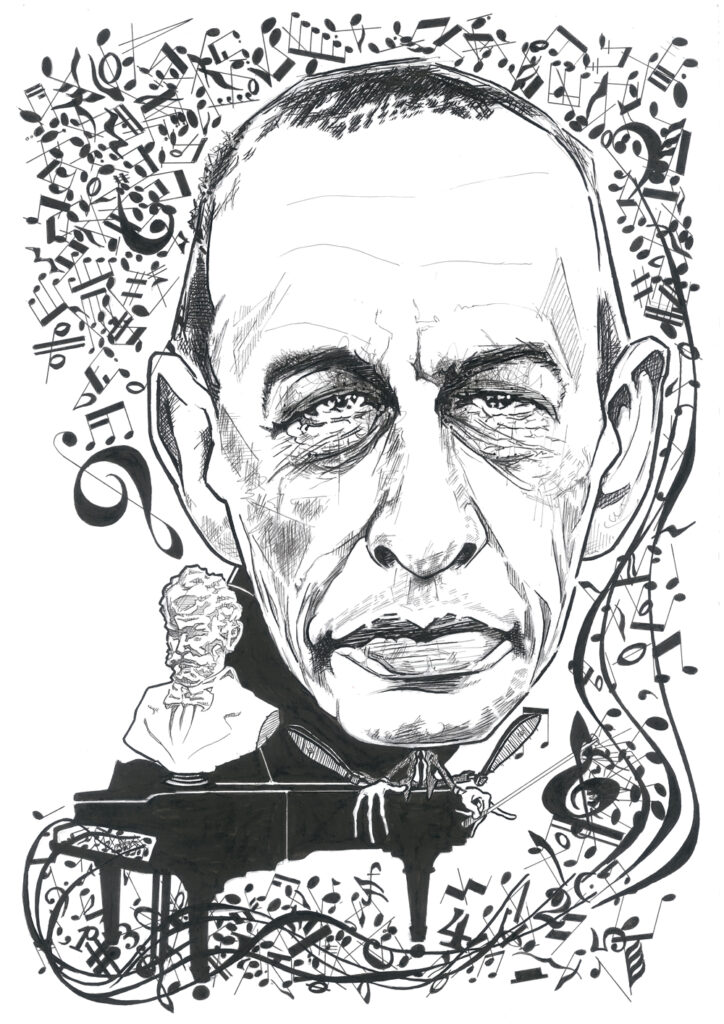
SERGEI RACHMANINOFF (1873—1943)
The great Russian composer, virtuoso pianist and conductor—he of the unfeasibly long fingers—poses on his piano with the bust of one of his key mentors, Tchaikovsky.
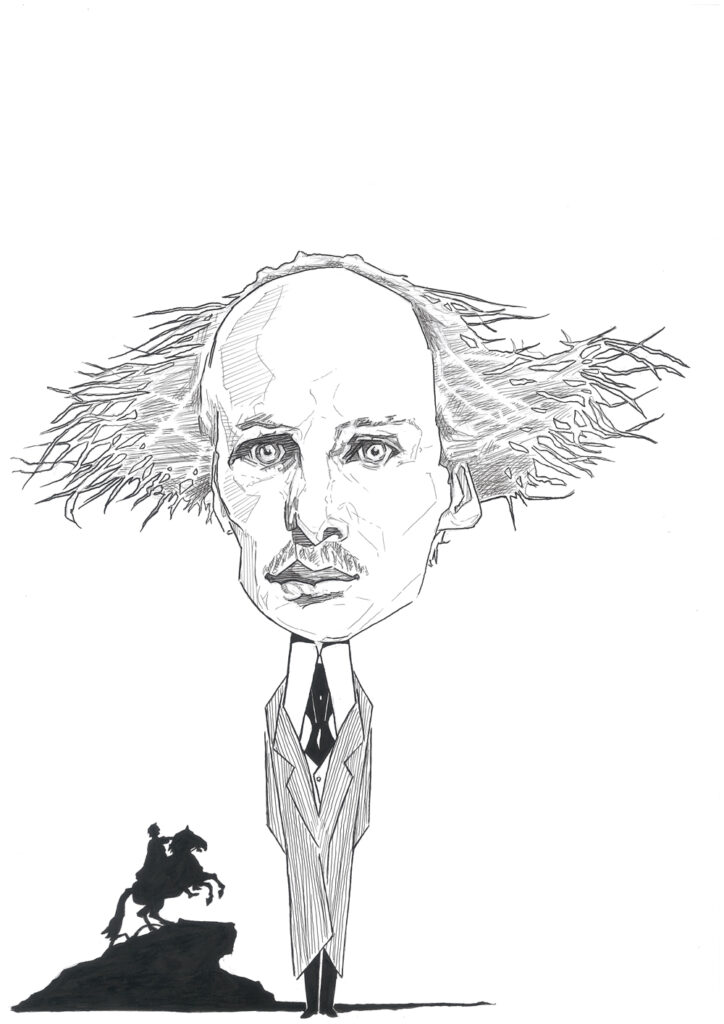
ANDREI BELY (1980—1934)
Born and raised in Moscow, the Symbolist poet Boris Bugaev adopted the pseudonym Andrei Bely (Andrew White) and, under the influence of the philosophy of Vladimir Solovyov, wrote a number of significant essays clearly imbued with the latter’s mysticism and preoccupation with eschatology. His first major literary work was Severnaya simfoniya (‘The Northern Symphony’) published in 1901, in which he employed an irregular metre and combined prose, poetry, music and, to some degree, painting. But it is Bely’s great novel Petersburg, published in serial form from 1913 to 1914, for which he is best remembered and celebrated in the West.
Albert Paretsky: ‘For Bely, language organises chaos. The poet finds images in the internal world of dreams. Music has an organising power beyond that of language, which language attempts to imitate. Under the influence of Vladimir Solovyov he looked to the union of Divine Wisdom or Sophia with the Eternal Logos as the principle behind symbolic images. Later, under the spell of Rudolf Steiner, he found the source of inspiration in the eternal dwelling of the Logos from which the human ego descends into flesh. The task of the poet is to recover the memory of the time before he left the realm of the Logos and to return to that realm by participating in Christ’s ascent to the Cross.’ (‘Chaos, Language, and Logos: How the Poet Participates in the Creating Activity of the Word in the Thought of Andrei Bely’—New Blackfriars, Vol. 97, No. 1070, CUP.)
In this illustration, Bely stands before the Bronze Horseman, the equestrian statue of Peter the Great in Senate Square, St Petersburg, which features as a ‘character’ in its own right in his great eponymous novel.

BRUNO SCHULZ
Polish Jewish writer & artist, born and died in Drohobych, Ukraine (1892-1942), Schulz was murdered by a Nazi officer due to a petty and appallingly inhumane grudge. Here, an ever-defiant and artistically-gifted Schulz lives on, pictured against a backdrop of buildings in Drohobych. To his right looms the great Choral Synagogue, built mid-19C, which served as a Soviet-owned warehouse after WWII, but, following a four-year renovation project, it was handed back to the Jewish community in 2018.



DORA PEJAČEVIĆ
Often described as the matriarch of Croatian composers, she gets three illustrations just to demonstrate how a limited variety of old photos can lead to very different outcomes, even with two of them utilising the same pose; and because I wanted to portray her as a young, gifted & idealistic musician & composer growing up in the family castle in Našice (she was a Countess) and, years later, towards the end of her short life (1885-1923), as a relatively established artist. Until recently she’s been pretty much disregarded in the West, largely due to barely concealed misogyny & snobbery, but amends are being made. This year’s BBC Proms included several of her works, finishing up with her Symphony in F sharp minor.

ZOLTÁN KODÁLY (1882-1967)
His name synonymous with the method of music instruction centred on group instruction, learning by singing and hand signs, solfège and folk music, Kodály is pictured here as a very young man carrying a phonograph cylinder to record and analyse Hungarian folk songs. He was preceded in applying this new technology by fellow Hungarian Béla Vikár who was compelled to exploit it, given that he himself had no musical training. For this reason Vikár focused on the poetry found in folk songs, while melodic analysis was left to István Kereszty, and, a few years later, Béla Bartók, who collaborated with Kodály from 1905 on a close scientific collection and study of Hungarian folk music.

IRINA RATUSHINSKAYA
The Odesa-born poet (1954—2017) was sentenced to seven years in prison on her 29th birthday for voicing ‘anti-Soviet agitation and propaganda’ in her work. She never stopped writing poems in prison, despite the risk of further and extended sentences and physical danger to herself (she was tortured and held in solitary confinement for some of that time). She scribbled on whatever scraps of paper she could find, and scratched her poems onto bars of prison soap with matchsticks, washing them clean after having committed the lines to memory. In one of her Poems from Prison she muses on getting ‘a tame mouse/while having a dog is impossible/And he and I will go along, read letters in the corner’ and, after declaring that her mouse will follow her anywhere that she may be transported, she concludes ‘For we’re both old zeks—I/and my long-tailed beast./We’ll make a home behind any bars,/beyond any February—and spring…’ (A zek was an inmate of a USSR labour camp. Poem translated by Frances Padorr Brent and Carol Avins.)
Ratushinskaya was released in October 1986, on the eve of the Reykjavik summit between Ronald Reagan and Mikhail Gorbachev. In this drawing she freely exchanges symbolic bars of prison soap with her husband, the human rights activist Igor Gerashchenko, The mouse, now also free, looks on.

LEOŠ JANÁČEK
The Czech composer (1854-1928) tries to shield two large hens at the start of The Cunning Little Vixen, the first opera to be based on a comic book! (or a serialised and illustrated novella), written by Rudolf Těsnohlidek and drawn by Stanislav Lolek. As opposed to the other animals realistically portrayed here (all characters in the opera), Janáček’s two hens are drawn with comically-exaggerated features—a contrast to indicate the opera is just getting under way, heralded by a cloudburst (…the falling notes in the form of a shower open the score, minus the yet-to-descend bar lines and accidentals, to reflect the spontaneity of this natural phenomenon; the opera is all about the cycle of life and the natural world).
Janáček asked for (and got) a performance of the closing music of the opera for his funeral; at this point the story has come full circle and the grandchild frog—in fact played by a child—cries with reference to the frog in Act One: “That wasn’t me. That was my grandaddy. He used to tell me about you.” (The German translator of the work, Max Brod, objected to the frog, as he wanted a last glorious hymn to nature from the main human character, the Forester. Janáček ignored him.)
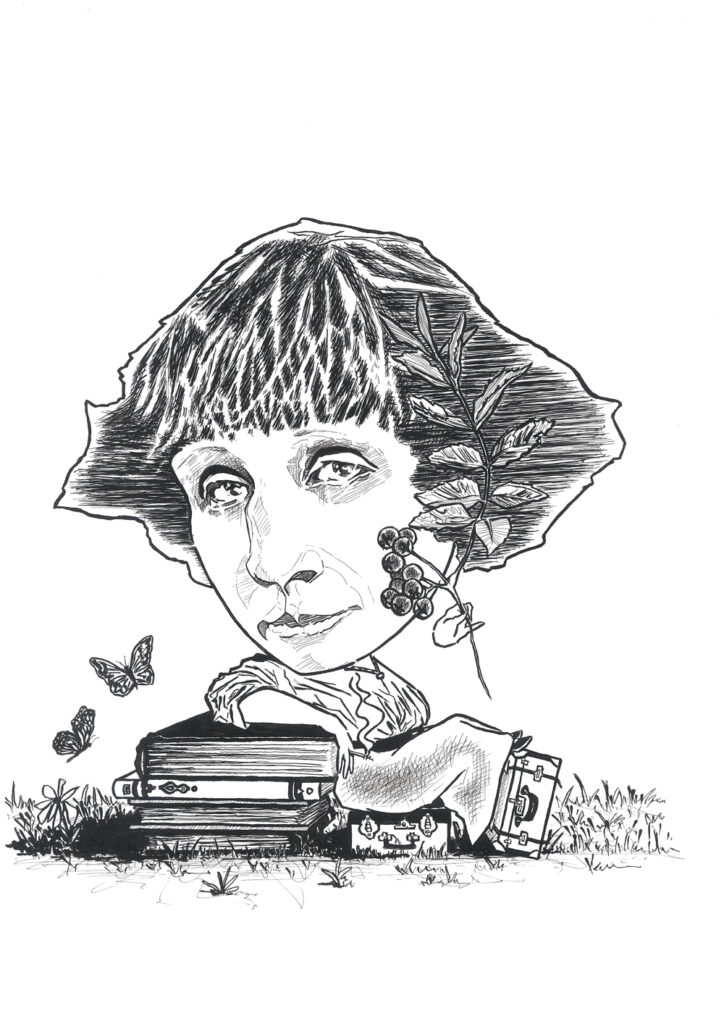
MARINA TSVETAEVA (1892-1941)
Now little known in the West, Tsvetaeva was one of the great Russian lyrical poets of the first half of the twentieth century. She witnessed and wrote about the Russian Revolution and the subsequent Moscow famine and tried to save her daughter Irina by placing her in an orphanage where she later died from starvation. Tsvetaeva herself died by suicide in 1941. She never recoiled from chronicling her times in all their brutality and horror, and she wrote in language and metre that was frequently as innovative as it was bold.
Tsvetaeva lived in exile for some years, where her worked was met with near-indifference, and from where she yearned to return to her native land. In this illustration she reclines on her luggage and holds a rowan branch. In Natasha’s Dance, Orlando Figes writes: ‘The rowanberry tree stirred up painful memories for the exiled poet … It was a reminder of her long-lost childhood in Russia and the one native “birthmark” that she could neither disguise nor bury … From her first attempts at verse, Tsvetaeva adopted the rowanberry tree as a symbol of her solitude: “The red mound of a rowanberry kindled/Its leaves fell, and I was born.”’
Figes continues: ‘Of the many factors that lay behind Tsvetaeva’s return to Stalin’s Russia, the most important was her desire to feel the Russian soil beneath her feet … Like most emigrés, she was torn between two different notions of her native land. The first was the Russia that “remains inside yourself” … This interior Russia was a country that was not confined to any territory … The other Russia was the land itself—the place that still contained memories of home … She missed the open landscape, the sound of Russian speech, and this visceral web of associations was the inspiration for her creativity.’
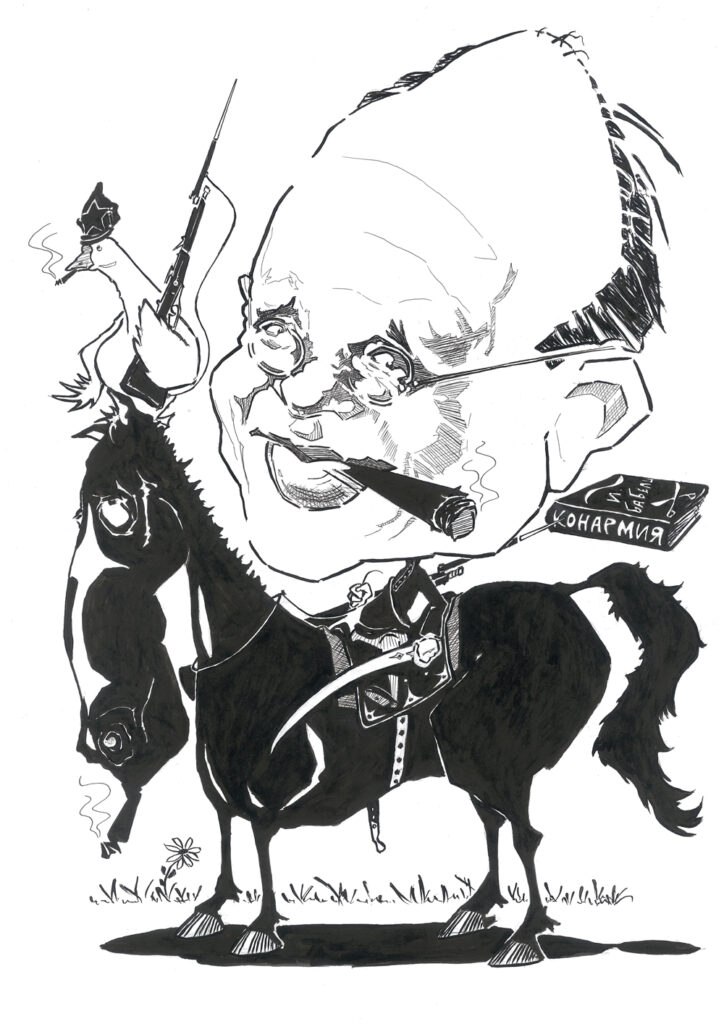
ISAAC BABEL (1894—1940)
Best known for his short story collections, Red Cavalry (set during the Polish-Soviet War and about the 1st Cavalry Army, all based on Babel’s diaries when he was employed as a journalist assigned to the army), and Odessa Stories (which take place in the dying days of the Russian empire and at the start of the revolution), Babel was born and raised in Odessa to Jewish parents. His faith instilled in him a love and fluent knowledge of Yiddish and Hebrew, but he quickly became equally at home in literary French, in which he composed his earliest work. Although Babel was treated appallingly by the Soviet State, which saw him tried and executed on bogus charges of spying and being ‘an enemy of the party and Soviet regime’, Babel’s rehabilitation began in 1954 with the so-called ‘thaw’ under Khrushchev. Babel is depicted here with a smile because, although he lived, wrote and died under the darkest clouds of Soviet oppression, his irrepressible humanity and humour shine through his work. He is accompanied by the goose from his great short tale, ‘My First Goose’—‘a classic story of violence, war, and the divided self …’ in the words of American writer George Saunders.

SLAVOJ ŽIŽEK
In these dangerous and alarming times, Slovenian philosopher Žižek attempts a pirouette atop an inverted globe spinning off its axis. He holds works by three of his favourite writers, on which the composer Schoenberg is perched. Žižek has repeatedly said that Schoenberg’s Gurre-Lieder is the disc he’d most want with him on his ‘Desert Island’ and this image of the composer is taken from his own self-portrait, inspired by the standing ovation he received for Gurre-Lieder after a decade of indifference & a fair amount of ridicule, beginning with the premiere’s of his First and Second String Quartets back in 1907-8. Following the 2013 world premiere of Gurre-Lieder at Vienna’s Musikverein, a livid Schoenberg famously kept his back turned to the audience’s ovation and only faced his orchestra— hence his faceless self-portrait, conceived in a rage.
From Žižek’s left foot dangles a copy of an Abercrombie & Fitch catalogue. Žižek controversially wrote a piece for the 2003 edition (which was also the last) and was accused of being a shallow, money-obsessed opportunist for doing so; but he didn’t care and said it was a lot more fun writing for Abercrombie & Fitch than for some dry-as-dust academic journal.

DZIGA VERTOV
With the indispensable assistance of his film editor wife, Yelizaveta Svilova, and his intrepid cameraman brother, Mikhail Kaufman, the Polish-born Vertov (1896—1954) produced and directed one of the greatest-ever early film documentaries, Man with a Movie Camera (1929). (His given name was David Kaufman; Dziga Vertov was a pseudonym which means ‘Spinning Top’.) Vertov was hired by the Ukraine State Studio (under Soviet rule) to create a film of Soviet citizens at work and at play, and Vertov was adamant that his film challenge and overhaul the early grammar of cinema, to be severed from the stultifying traditions of literature and theatre. Filming locations covered Kyiv, Odesa, Kharkiv and Moscow. In addition to his highly original, even revolutionary film and editorial language and techniques, Vertov and his brother employed and adapted the latest cameras and equipment, on which in this illustration he rides over Moscow’s Strastnaya Square (re-named Pushkinskaya Square in 1931) and the tower of the soon-to-be destroyed Strasnoy (Passion) Monastery.


RUDOLF NUREYEV (1938—1993)
Considered by many to have been the greatest male ballet dancer of his time, Nureyev gets two—but warrants countless—portraits, if only for the sheer expressive beauty and dynamism of his
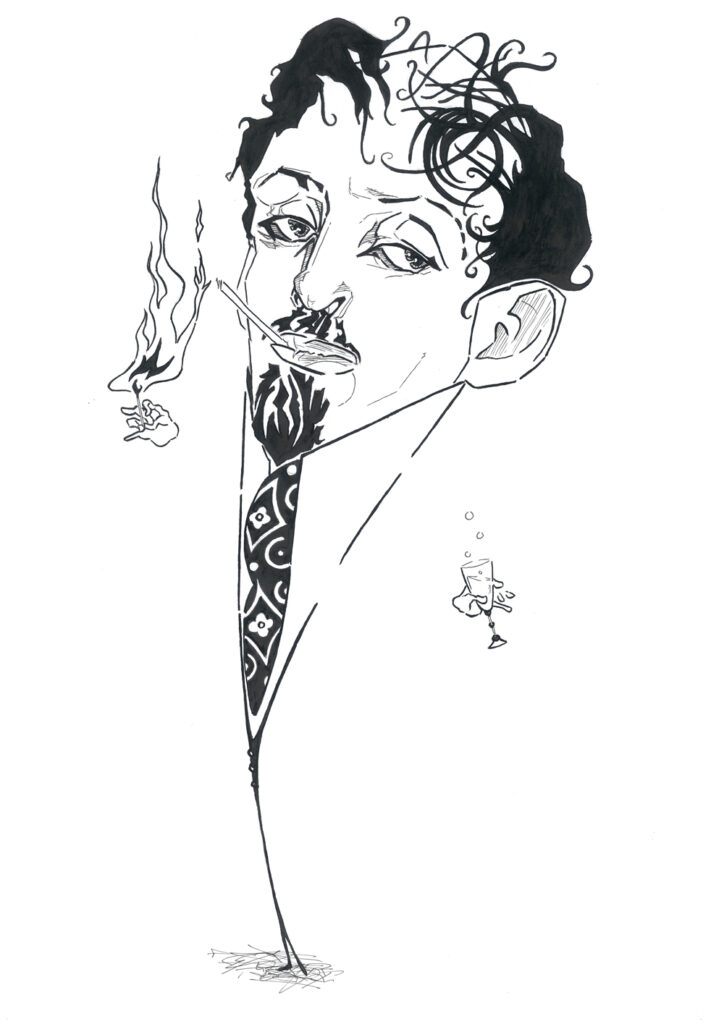
MIKHAIL KUZMIN (1872—1936)
One of the great poets and writers of the Silver Age in Russian art and literature, Kuzmin was born into nobility in Yaroslavl and raised in St Petersburg where he studied music under the composer Rimsky-Korsakov. An aesthete and noted bon vivant, in 1913 Kuzmin began a relationship with fellow poet Yuri Yurkun with whom he lived (along with the latter’s mother and then, for a short time, his wife) until Kuzmin’s death in 1936 of pneumonia. To this day, his most famous work outside Russia remains Wings (still in print and in English translation), likely the first Russian novel to overtly and delicately address the issue of male homosexuality. The novel was predictably lambasted upon its publication, but it has endured and is now regarded as a minor classic of Russian literature, bearing comparison with similar work by Wilde, Proust and Gide, and obliquely parodied by Nabokov in his novel The Eye.

ISAIAH BERLIN
The Riga-born, Russian-British liberal intellectual Berlin (1909-1997) dances Gene Kelly-style atop All Souls, Oxford, where, as Chichele Professor of Social and Political Theory he delivered his now classic inaugural lecture ‘Two Concepts of Liberty’ in 1958. Berlin was in and out of intellectual fashion throughout his long academic career, but he ‘danced’ through it all with grace and class right to the end, whatever the political weather.
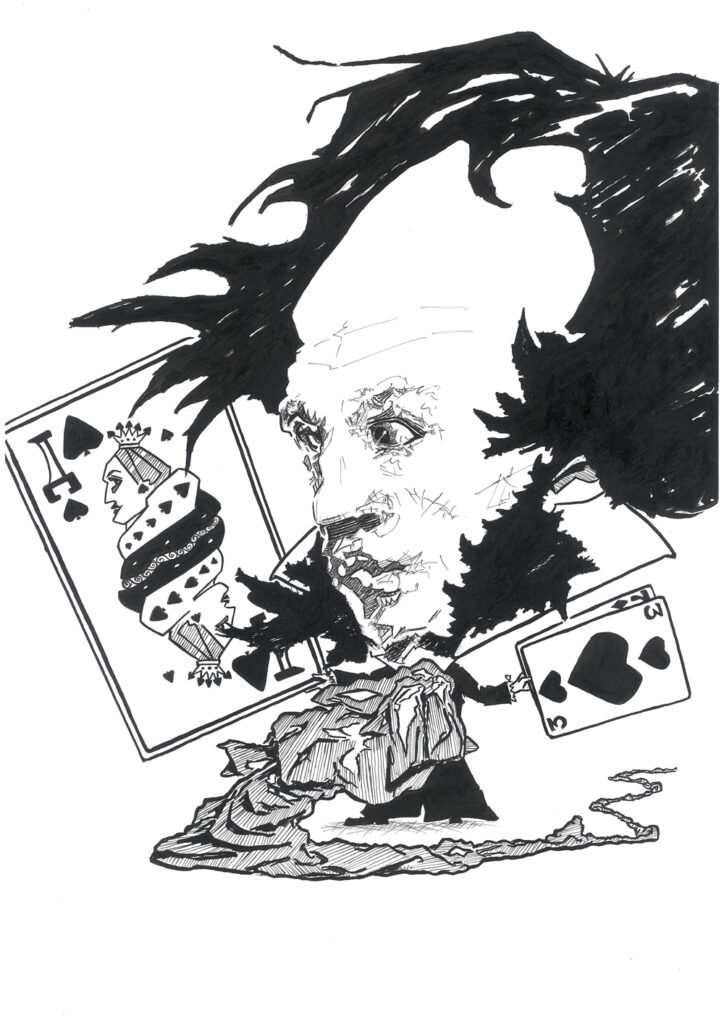
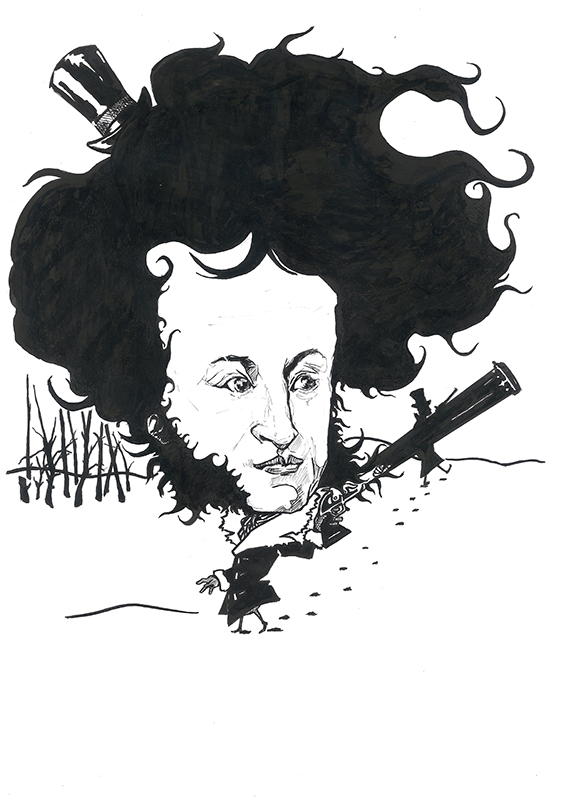
ALEXANDER PUSHKIN (1799—1837)
Widely considered to be the father of Russian literature, Pushkin was the author of the dramas Boris Godunov, and Mozart and Salieri (inspiration for Peter Shaffer’s Amadeus), as well as the poetic masterpiece ‘The Bronze Horseman’. Beyond Russia, he is perhaps best known for his great novel in verse, Eugene Onegin, not to mention his many short stories, including ‘The Queen of Spades’. He is honoured here with two drawings, the first based on the famous 1827 portrait by Orest Kiprensky, but portraying the writer taking part in the duel that was to kill him at such a young age; and the second a creative ‘composite’ (Pushkin’s portraits vary somewhat in appearance and hence credibility) with the three key playing cards that feature in the denouement of the aforementioned ’The Queen of Spades’.

MIKHAIL BULGAKOV
The great Kyiv-born writer (1891-1940) is portrayed at a game of chess. Behemoth, the giant demonic black cat from Bulgakov’s great novel, The Master and Margarita, looms over him. Behemoth plays a fine game of chess, enjoys his vodka and has a penchant for pistols.
